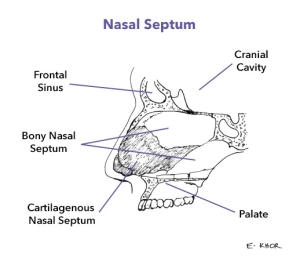Septoplasty

Septoplasty is an operation to straighten the nasal septum.
What is the Nasal Septum?
The nasal septum is the wall between the left and right nasal cavities. It extends from the tip of the nose to the back of the nasal cavity and from the floor of the nasal cavity, where it is attached to the hard palate, to the roof of the nasal cavity where is attached to the skull base.
The front portion of the nasal septum is composed of cartilage which is relatively soft and pliable. The back of the nasal septum is made of bone.
Indications for Septoplasty
The nasal septum is rarely perfectly straight. Minor deviations of the nasal septum are not significant. In some instances there may be more significant deviations or bends in the septum particularly with previous trauma. Often the trauma can be a relatively minor event in childhood that puts creases in the cartilage resulting in significant deviations with growth.
Septoplasty to correct these deviations may be considered in the following circumstances;
- Nasal obstruction
- Cosmetic deformity of the external nose relating to underlying deviations of the septum
- Access to other areas of the nose in sinus surgery
- Some cases of snoring and sleep apnoea
Septoplasty is frequently done in conjunction with turbinate surgery. More information on turbinate surgery can be found here.
The operation
Septoplasty is performed in hospital usually under a general anaesthetic. An incision is made just inside the nostril on one side. The soft tissue overlying the nasal septum is elevated to allow access to the bony and cartilaginous septum. Once a good view has been obtained posterior bony deviations are removed and the cartilage is refashioned to construct straight septum. It is important that most of the cartilage at the front of the nose is preserved to maintain support for the external nose.
The incision is then closed with dissolving sutures and in most cases a light nasal pack is left in place overnight to control bleeding.
After surgery
An overnight stay in hospital is normal after the surgery. It is not uncommon have a small amount of bleeding on the first night. Pain is not normally a major feature.
Discharge from hospital
Around 7 AM the following morning the nursing staff will remove the packs. It is not uncommon to have a slight bleed at this point. I will do a ward round at 730 AM to make sure all is well. Providing there are no concerns with bleeding or nausea, discharge home will normally occur mid-morning.
Diet
Following nasal surgery it is best to avoid food and drinks that are too hot as they may increase bleeding. A cool to warm normal diet is satisfactory.
Activity
Because the nose is such a vascular structure excessive physical activity may provoke bleeding. I therefore suggest that strenuous physical activity is avoided for two weeks.
Pain relief
Pain is not normally excessive following nasal surgery.
Surgery on the nose does however result in the release of natural compounds called inflammatory mediators. These are the same compounds that are released in viral infections and it is not at all unusual to have symptoms similar to a virus, such as lethargy and headache. Paracetamol is normally sufficient however panadeine forte is also prescribed in case it is required.
Nurofen should not be used.
Other medications
I normally also prescribe antibiotics to be used for one week.
Salt-water nasal sprays or douches are also provided and help clear some of the mucus and congealed blood. These can be used as much or as little as desired as they are essentially for comfort.
Nose blowing
It is best to avoid nose blowing from the first few days as excessive or vigorous nose blowing may precipitate bleeding. Thereafter the nose may be blown gently, both nostrils open at the same time.
Nasal obstruction
It is normal to have some nasal obstruction for several days to a week following Septoplasty. This is due to swelling and congestion in a confined space. Sleeping with the head elevated may help to some degree.
Bleeding
It is normal to have bloody mucous discharge from the nose or an occasional small fresh bleed for a few days after the operation. If bleeding is heavy or prolonged you should contact me.
Postoperative instructions
You will be given instructions for care upon discharge. These are also available to download here. At discharge you will also be given a post-operative appointment and my mobile phone number.